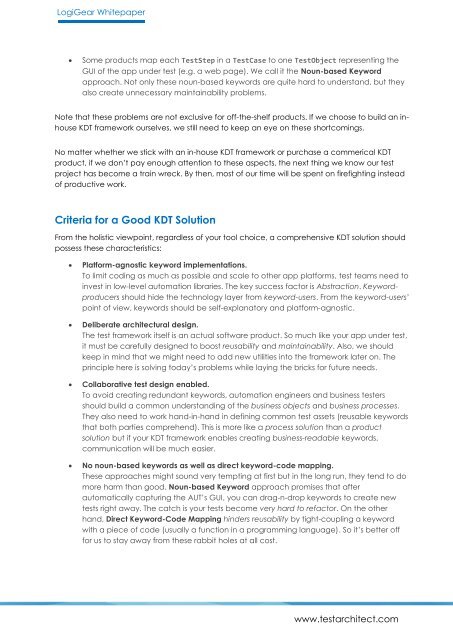The Evolution of Keyword Driven Testing
You also want an ePaper? Increase the reach of your titles
YUMPU automatically turns print PDFs into web optimized ePapers that Google loves.
LogiGear Whitepaper<br />
<br />
Some products map each TestStep in a TestCase to one TestObject representing the<br />
GUI <strong>of</strong> the app under test (e.g. a web page). We call it the Noun-based <strong>Keyword</strong><br />
approach. Not only these noun-based keywords are quite hard to understand, but they<br />
also create unnecessary maintainability problems.<br />
Note that these problems are not exclusive for <strong>of</strong>f-the-shelf products. If we choose to build an inhouse<br />
KDT framework ourselves, we still need to keep an eye on these shortcomings.<br />
No matter whether we stick with an in-house KDT framework or purchase a commerical KDT<br />
product, if we don’t pay enough attention to these aspects, the next thing we know our test<br />
project has become a train wreck. By then, most <strong>of</strong> our time will be spent on firefighting instead<br />
<strong>of</strong> productive work.<br />
Criteria for a Good KDT Solution<br />
From the holistic viewpoint, regardless <strong>of</strong> your tool choice, a comprehensive KDT solution should<br />
possess these characteristics:<br />
<br />
<br />
<br />
<br />
Platform-agnostic keyword implementations.<br />
To limit coding as much as possible and scale to other app platforms, test teams need to<br />
invest in low-level automation libraries. <strong>The</strong> key success factor is Abstraction. <strong>Keyword</strong>producers<br />
should hide the technology layer from keyword-users. From the keyword-users’<br />
point <strong>of</strong> view, keywords should be self-explanatory and platform-agnostic.<br />
Deliberate architectural design.<br />
<strong>The</strong> test framework itself is an actual s<strong>of</strong>tware product. So much like your app under test,<br />
it must be carefully designed to boost reusability and maintainability. Also, we should<br />
keep in mind that we might need to add new utilities into the framework later on. <strong>The</strong><br />
principle here is solving today’s problems while laying the bricks for future needs.<br />
Collaborative test design enabled.<br />
To avoid creating redundant keywords, automation engineers and business testers<br />
should build a common understanding <strong>of</strong> the business objects and business processes.<br />
<strong>The</strong>y also need to work hand-in-hand in defining common test assets (reusable keywords<br />
that both parties comprehend). This is more like a process solution than a product<br />
solution but if your KDT framework enables creating business-readable keywords,<br />
communication will be much easier.<br />
No noun-based keywords as well as direct keyword-code mapping.<br />
<strong>The</strong>se approaches might sound very tempting at first but in the long run, they tend to do<br />
more harm than good. Noun-based <strong>Keyword</strong> approach promises that after<br />
automatically capturing the AUT’s GUI, you can drag-n-drop keywords to create new<br />
tests right away. <strong>The</strong> catch is your tests become very hard to refactor. On the other<br />
hand, Direct <strong>Keyword</strong>-Code Mapping hinders reusability by tight-coupling a keyword<br />
with a piece <strong>of</strong> code (usually a function in a programming language). So it’s better <strong>of</strong>f<br />
for us to stay away from these rabbit holes at all cost.<br />
www.testarchitect.com


